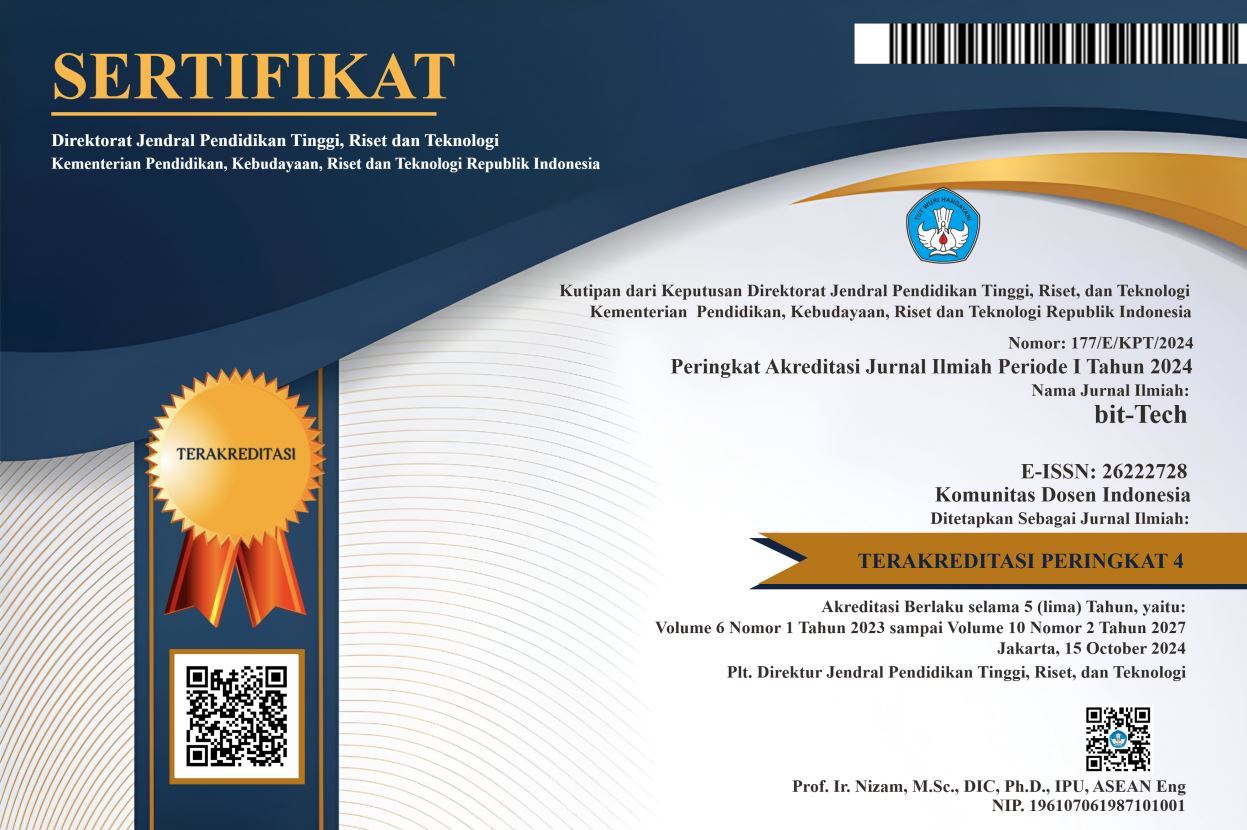Web-Based POS with Apriori Market Basket Analysis
DOI:
https://doi.org/10.32877/bt.v6i3.926
Keywords:
Apriori, Association rule, Data Mining, Market Basket Analysis, Point Of Sales
Abstract
This research project focuses on the design and development of a web-based Point of Sale (POS) application that incorporates advanced analytical techniques, specifically Market Basket Analysis with the Apriori algorithm and the Association Rule method. The primary objective of this web-based POS system is to empower retailers in managing their sales transactions efficiently and gaining valuable insights into customer purchasing behavior. The web-based POS application is multifaceted, offering features such as sales transaction recording, product inventory management, and customer data tracking. What sets it apart is the integration of the Apriori algorithm and Association Rule method, which enable the system to analyze and understand customer purchasing patterns. It identifies strong product associations and establishes rules that support intelligent decision-making for businesses. The advantages of Market Basket Analysis are substantial. Retailers can identify relevant purchase patterns, such as frequently co-purchased products or cross-selling opportunities. This information can be used to enhance marketing strategies, optimize product placement in stores, and create bundled product offerings, ultimately boosting sales and revenue. By analyzing transaction data and recognizing patterns, retailers can streamline their operations, minimize wastage, and allocate resources more effectively. In summary, this research project showcases the transformative potential of integrating Market Basket Analysis, the Apriori algorithm, and the Association Rule method into web-based POS systems. By doing so, retailers can enhance operational efficiency, boost sales, and improve customer satisfaction, ultimately leading to more successful and competitive businesses in the retail sector.
Downloads
References
A. N. Sagin and B. Ayvaz, “Determination of association rules with market basket analysis: application in the retail sector,” Southeast Eur. J. Soft Comput., vol. 7, no. 1, 2018.
A. R. Riszky and M. Sadikin, “Data Mining Menggunakan Algoritma Apriori untuk Rekomendasi Produk bagi Pelanggan,” J. Teknol. dan Sist. Komput., vol. 7, no. 3, pp. 103–108, 2019.
N. Ramadhani, A. Supikar, and W. Zumam, “Penerapan Market Basket Analysis Menggunakan Metode Multilevel Association Rules dan Algoritma ML_T2L1 Pada Data Order PT. Unirama,” InfoTekJar J. Nas. Inform. dan Teknol. Jar., vol. 4, no. 2, pp. 261–274, 2020.
M. Badrul, “Algoritma asosiasi dengan algoritma apriori untuk analisa data penjualan,” J. Pilar Nusa Mandiri, vol. 12, no. 2, pp. 121–129, 2016.
J. Suntoro, DATA MINING: Algoritma dan Implementasi dengan Pemrograman php. Elex Media Komputindo, 2019.
A. Salam and M. Sholik, “Implementasi Algoritma Apriori untuk Mencari Asosiasi Barang yang Dijual di E-commerce OrderMas,” Techno. com, vol. 17, no. 2, pp. 158–170, 2018.
W. Choiriah and A. Akmal, “PENERAPAN DATA MINING MENGGUNAKAN METODE ASSICIATION RULE DENGAN ALGORITMA APRIORI UNTUK ANALISA POLA PENJUALAN BARANG,” JURTEKSI (Jurnal Teknol. dan Sist. Informasi), vol. 5, no. 2, pp. 193–198, 2019.
D. Melati and T. S. Wahyuni, “Association Rule Dalam Menentukan Cross-Selling Produk Menggunakan Algoritma Fp-Growth,” Voteteknika (Vocational Tek. Elektron. dan Inform., vol. 7, no. 4, pp. 102–111, 2020.
H.-K. Lin, C.-H. Hsieh, N.-C. Wei, and Y.-C. Peng, “Association rules mining in R for product performance management in industry 4.0,” Procedia CIRP, vol. 83, pp. 699–704, 2019.
M. Syahril, K. Erwansyah, and M. Yetri, “Penerapan Data Mining untuk menentukan pola penjualan peralatan sekolah pada brand wigglo dengan menggunakan algoritma apriori,” J. Teknol. Sist. Inf. Dan Sist. Komput. TGD, vol. 3, no. 1, pp. 118–136, 2020.
K. N. W. Krisna Nata Wijaya, R. F. M. Reza Firsandaya Malik, and S. N. Siti Nurmaini, “Analisa Pola Frekuensi Keranjang Belanja Dengan Dengan Perbandingan Algoritma Fp-Growth (Frequent Pattern Growth) dan Eclat pada minimarket,” JATISI (Jurnal Tek. Inform. dan Sist. Informasi), vol. 7, no. 2, pp. 364–373, 2020.
A. Sharif, “Data mining untuk memprediksi itemset promosi penjualan barang menggunakan metode market basket analysis (mba)(studi kasus: toko sentra ponsel),” J. Mantik Penusa, vol. 3, no. 2, pp. 117–123, 2019.
Y. Afrianto, N. B. Ginting, S. Suratun, and Y. Nelawati, “Sistem Informasi Inventory POS (Point of Sales) Berbasis Web Pada Counter Cellular,” JURTEKSI (Jurnal Teknol. dan Sist. Informasi), vol. 6, no. 2, pp. 125–134, 2020.
S. D. Ikramina, N. Fauzan, M. Tuga, K. E. Robert, and J. Riyanto, “Data Mining Implementation with Association Method and Apriori Algorithm for Store Display Design in Home Center Indonesia,”, vol. 15, no. 11, p. 1221, 2021.
S. Huber, H. Wiemer, D. Schneider, and S. Ihlenfeldt, “DMME: Data mining methodology for engineering applications–a holistic extension to the CRISP-DM model,” Procedia Cirp, vol. 79, pp. 403–408, 2019.
R. Saputra and A. J. P. Sibarani, “Implementasi Data Mining Menggunakan Algoritma Apriori Untuk Meningkatkan Pola Penjualan Obat,” JATISI (Jurnal Tek. Inform. Dan Sist. Informasi), vol. 7, no. 2, pp. 262–276, 2020.
Downloads
Published
How to Cite
Issue
Section
License
Copyright (c) 2024 bit-Tech : Binary Digital - Technology

This work is licensed under a Creative Commons Attribution-ShareAlike 4.0 International License.
I hereby assign and transfer to bit-Tech all exclusive copyright ownership rights to the above work. This includes, but is not limited to, the right to publish, republish, downgrade, distribute, transmit, sell, or use the work and other related materials worldwide, in whole, or in part, in all languages, in electronic, printed, or any other form of media, now known or hereafter developed and reserves the right to permit or license a third party to do any of the above. I understand that this exclusive right will belong to bit-Tech from the date the article is accepted for publication. I also understand that bit-Tech, as the copyright owner, has sole authority to license and permit reproduction of the article. I understand that, except for copyright, any other proprietary rights associated with the work (e.g. patents or other rights to any process or procedure) must be retained by the author. In addition, I understand that bit-Tech permits authors to use their papers in any way permitted by the applied Creative Commons license.


 DOI :
DOI :
 Abstract views: 352
/
Abstract views: 352
/  PDF downloads: 234
PDF downloads: 234











